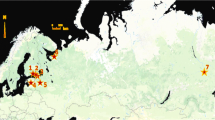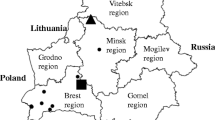Abstract
Climate change with an increase in average temperature may be responsible for propagation of temperature-dependent vectors and/or vector-associated pathogens in regions that were previously not endemic. The analysis of climate data of Brandenburg state (Germany) had showed that the extrinsic development of Dirofilaria repens, the causative agent of canine subcutaneous dirofilariosis, was possible from the years 2001 to 2012. This finding, associated to the movement of infected dogs and their relocation from endemic European areas to Germany makes possible a rapid endemization of the infection and highlight the risk for human health, being D. repens a frequent cause of zoonotic infections.




Similar content being viewed by others
References
Anderson RC (2000) Nematode parasites of vertebrates. Their development and transmission, 2nd edn. CABI Publishing, Wallingford, Oxon
Auer H, Susani M (2008) The first autochthonous dirofilariosis in Austria. Wien Klin Wochenschr 120:104–106
Babal P, Kobzova D, Novak I, Dubinsky P, Jalili N (2008) First case of human dirofilariosis in Slovak Republic. Bratisl Lek Listy 109:486–488
Bain O (1978) Développement en camargue de la filaire du chien, Dirofilaria repens railliet et Henry, 1911, chez les Aedes halophile. Bull Muséum Natl Hist Nat 351:19–27
Cancrini G, Yanchang S, Della Torre A, Coluzzi M (1988) Influenza della temperatura sullo sviluppo larvale di Dirofilaria repens in diverse specie di zanzare. Parassitologia 30:38
Cancrini G, Pietrobelli M, di Regalbono AF F, Tampieri MP, della Torre A (1995) Development of Dirofilaria and Setaria nematodes in Aedes albopictus. Parassitologia 35:141–145
Cancrini G, Romi R, Gabrielli S, Toma L, Di Paolo M, Scaramozzino P (2003) First finding of Dirofilaria repens in a natural population of Aedes albopictus. Med Vet Entomol 17:448–451
Cancrini G, Magi M, Gabrielli S, Arispici M, Tolari F, Dell’Omodarme M, Prati MV (2006) Natural vectors of Dirofilariasis in rural and urban areas of the Tuscan region, central Italy. J Med Entomol 43:574–579
Coluzzi M (1964) Osservazioni sperimentali sul comportamento di Dirofilaria repens in diversi gruppi di artropodi ematofagi. Parasitologia 5:57–63
Demiaszkiewicz AW, Polanczyk G, Pyziel AM, Kuligowska I, Lachowicz J (2009) The first foci of dilofilariosis of dogs evoked by Dirofilaria repens Railliet et Henry, 1911 in central Poland. Wiad Parazytol 55:367–370
Duscher G, Feiler A, Wille-Piazzai W, Bakonyi T, Leschnik M, Miterpáková J, Nowotny N, Joachim A (2009) Detection of Dirofilaria in Austrian dogs. Berl Münch Tierärztl Wochenschr 122:199–203
DWD (2012) Ergebnisse der Klimaforschung müssen Teil des Verwaltungshandelns werden Pressemitteilung 03.05. Offenbach. http://www.dwd.de/bvbw/appmanager/bvbw/dwdwwwDesktop?_nfpb=true&_pageLabel=dwdwww_menu2_presse&T98029gsbDocumentPath=Content%2FPresse%2FPressemitteilungen%2F2012%2F20120503__PK__Klimawandel__news.html (08.25.2012)
Dyachenko V, Daugschies A (2012) Kanine kutane Dirofilariose–aktueller epidemiologischer Stand. LBH: Proceedings 6. Leipziger Tierärztekongress–Tagungsband 1
Favia G, Lanfrancotti A, Della Torre A, Cancrini G, Coluzzi M (1996) Polymerase chain reaction-identification of Dirofilaria repens and Dirofilaria immitis. Parasitology 113:567–571
Fleck R, Kurz W, Quade B, Geginat G, Hof H (2009) Human dirofilariasis due to Dirofilaria repens mimicking a scrotal tumor. Urology 73(209):1–3
Fodor E, Fok E, Maka E, Lukats O, Toth J (2009) Recently recognized cases of ophthalmofilariasis in Hungary. Eur J Ophthalmol 19:675–678
Fortin JF, Slocombe JOD (1981) Temperature requirements for the development of Dirofilaria immitis in Aedes triseriatus and Ae. vexans. Mosq News 41:625–633
Genchi C, Rinaldi L, Mortarino M, Genchi M, Cringoli G (2009) Climate and Dirofilaria infection in Europe. Vet Parasitol 163:286–292
Genchi C, Kramer LH, Rivasi F (2011) Dirofilarial infections in Europe. Vector-Borne Zoonotic Dis 11:1307–1317
Guzeeva M, Guzeeva T, Afonin A, Kartashev V, Simon F (2012) Human Dirofilariasis caused by Dirofilaria repens in Russia (2006–2011). Proceedings Third Dirofilaria Days. Parma, June 21–22: 40
Hermosilla C, Pantchev N, Dyachenko V, Gutmann M, Bauer C (2006) First autochthonous case of canine ocular Dirofilaria repens in Germany. Vet Rec 158:134–135
Hirsch M, Pantchev N (2008) Vorkommenshäufigkeit der Reisekrankheiten Leishmaniose, Ehrlichiose, Babesiose und Dirofilariose bei in Deutschland lebenden Hunden. Kleintierprax 53:154–165
IPCC (2007) Klimaänderung, Zusammenfassungen für politische Entscheidungsträger. www.ipcc.ch/pdf/reports-nonUN-translations/deutch/IPCC2007-Vorspann.pdf (08.25.2012)
Jelinek T, Schulte-Hillen J, Löscher T (1996) Human dirofilariasis. Int J Dermatol 35:872–875
Kampen H (2012) Friedrich-Loeffler-Institut, Greifswald - Insel Riems Pers com
Kartashev V, Batashova I, Kartashov S, Ermakov A, Mironova A, Kuleshova Y, Ilyasov B, Kolodiy I, Klyuchnikov A, Ryabikina E, Babicheva M, Levchenko Y, Pavlova R, Pantchev N, Morchón R, Simón F (2011) Canine and human dirofilariosis in the Rostov Region (southern Russia). Vet Med Int. doi:10.4061/2011/685713
Keller L, Hartmann K, Wess G (2007) Fallbericht und Literaturübersicht kutaner Dirofilariose. Tierärztl Prax 35:31–34
Kershaw O, Dyachenko V, Gruber AD (2009) Kutane Dirofilariose in Deutschland. 52. Jahrestagung der DVG, Fachgruppe Pathologie; 6–8. März, Fulda
Kleiter M, Luckschander N, Willmann M (2001) Kutane Dirofilariose (Dirofilaria repens) bei zwei nach Österreich importierten Hunden. Kleintierpraxis 46:283–288
Lee SE, Song KH, Liu J, Kim MC, Park BK, Cho KW, Hasegawa A, Kim DH (2004) Comparison of the acid-phosphatase staining and polymerase chain reaction for detection of Dirofilaria repens infection in dogs in Korea. J Vet Med Sci 66:1087–1089
Löwenstein M, Spallinger E (2009) Erster autochthoner Fall einer Dirofilaria (Nochtiella) repens Infektion bei einem Hund in Österreich-ein Fallbericht. Wiener Tierärztl Monatsschr 99:84–187
Mandelli G, Mantovani A (1966) Su di un caso di infestazione massiva da Dirofilariarepens nel cane. Parassitologia 8:21–28
Mănescu R, Bărăscu D, Mocanu C, Pîrvănescu H, Mîndriă I, Bălăşoiu M, Turculeanu A (2009) Subconjunctival nodule with Dirofilaria repens. Chirurgia (Bucur) 104:95–97
McCall JW, Genchi C, Kramer LH, Guerrero J, Venco L (2008) Heartworm disease in animals and humans. Adv Parasitol 66:193–285
Muro A, Genchi C, Cordero M, Simon F (1999) Human dirofilariasis in the European Union. Parasitol Today 15:386–389
Naucke J, Lorentz S, Menn B, Mencke N (2011) Prävalenz von durch Ektoparasiten übertragenen Infektionskrankheiten (CVBDs) bei Import- und Reise-begleitenden Hunden in Deutschland und Prävention von CVBDs. Tierärztl Umschau 66:311–317
Overgaauw P, van Dijk E (2009) Autochthonous case of Dirofilaria repens in a dog in the Netherlands. Vet Rec 164:158
Pampiglione S, Rivasi F (2000) Human dirofilariasis due to Dirofilaria (Nochtiella) repens: an update of world literature from 1995–2000. Parassitologia 42:231–254
Pampiglione S, Rivasi F, Vakalis N (2000) Human pulmonary dirofilariasis: the first case observed in Greece. Ann Pathol 20:626–628
Pampiglione S, Rivasi F, Gustinelli A (2009) Dirofilarial human cases in the Old World, attributed to Dirofilaria immitis: a critical analysis. Histopathol 54:192–204
Pantchev N, Norden N, Lorentzen L, Rossi M, Rossi U, Brand B, Dyachenko V (2009a) Current surveys on the prevalence and distribiution of Dirofilaria spp. in dogs in Germany. Parasitol Res 105(Suppl 1):63–74
Pantchev N, Lorentzen L, Rossi M, Rossi U, Brand B, Dyachenko V (2009) Aktuelle Studie zur Vorkommenshäufigkeit von durch Stechmücken und Zecken übertragbaren Infektionen bei jagdlich genutzten Hunden im Mittleren Oberrhein. Tagung der DVG, Fachgruppe Parasitologie und parasitäre Krankheiten. 9–11. Juli 2008, Celle
Pantchev N, Etzold M, Daugschies A, Dyachenko V (2011) Diagnosis of imported canine filarial infections in Germany 2008–2010. Parasitol Res 109(Suppl 1):S61–S76
Perret-Court A, Coulibaly B, Ranque S, Bouvier C, Lena G, Goze C, Verschuur A (2009) Intradural dirofilariasis mimicking a Langerhans cell histiocytosis tumor. Pediatr Blood Cancer 53:485–487
Poppert S, Hodapp M, Krueger GH, Niesen WD, Kern WV, Tannich E (2009) Dirofilaria repens infection and concomitant meningoencephalitis. Em Inf Dis 15:1844–1846
Restani R, Rossi G, Semproni G (1962) Due interessanti reperti clinici in cani portatori di Dirofilaria repens. Atti Soc It Sci Vet 16:406–412
Révész E, Markovics G, Darabos Z, Tóth I, Fok E (2008) Dirofilaria in the abdominal cavity. Magy Seb 61:281–284
Rocconi F, Di Tommaso M, Traversa D, Palmier C, Pampurini F, Boari A (2012) Allergic dermatitis by Dirofilaria repens in a dog: clinical picture and treatment. Parasitol Res 111:493–496
Sassnau R, Dyachenko V, Pantchev N, Stöckel F, Dittmar K, Daugschies A (2009) Dirofilaria-repens-Befall in einem Schlittenhunde-Rudel im Land Brandenburg. Tierärztl Pra 37:95–101
Sassnau R, Kohn M, Demeler J, von Samson-Himmelstjerna G, Kohn B, Müller E (2012) Is Dirofilaria repens endemic in the Havelland (district in the state of Brandenburg, Germany). Third Dirofilaria Days 21–22
Simón F, Siles-Lucas M, Morchón R, Gonzáles-Miguel J, Mellardo I, Carretón E, Montoya-Alonso JA (2012) Human and animal dirofilariasis: the emergence of a zoonotic mosaic. Clin Microbiol Rew 25:507–543
Slocombe JOD, Surgeoner GA, Srivastava B (1989) Determination of heartworm transmission period and its use in diagnosis and control Proc Heartworm Symp ’89. America Heartworm Society, Washington, DC, pp 19–26
Svobodova Z, Svobodova V, Genchi C, Forejtek P (2006) The first report of autochthonous dirofilariosis in dogs in the Czech Republic. Helminthol 43:242–245
Szénási Z, Kovács AH, Pampiglione S, Fioravanti ML, Kucsera I, Tánczos B, Tiszlavicz L (2008) Human Dirofilariosis in Hungary: an emerging zoonosis in Central Europe. Wien Klin Wochenschr 120:96–102
Trotz-Williams LA, Trees AJ (2003) Systematic review of the distribution of the major vector-borne parasitic infections in dogs and cats in Europe. Vet Rec 152:97–105
Webber WAF, Hawking F (1955) Experimental maintenance of Dirofilaria repens and Dirofilaria immitis in dogs. Exp Parasitol 4:143–164
Zarnowska-Prymek H, Cielecka D, Salamatin R (2008) Dirofilariasis—Dirofilaria repens—first time described in Polish patients. Przegl Epidemiol 62:547–551
Author information
Authors and Affiliations
Corresponding author
Rights and permissions
About this article
Cite this article
Sassnau, R., Genchi, C. Qualitative risk assessment for the endemisation of Dirofilaria repens in the state of Brandenburg (Germany) based on temperature-dependent vector competence. Parasitol Res 112, 2647–2652 (2013). https://doi.org/10.1007/s00436-013-3431-2
Received:
Accepted:
Published:
Issue Date:
DOI: https://doi.org/10.1007/s00436-013-3431-2




